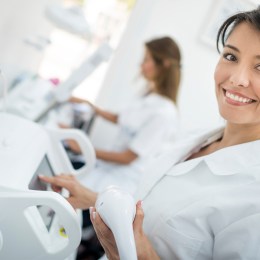For cancer patients, one of the most important coping mechanisms they have is living life as normally as possible, and that includes continuing to have aesthetics treatments.
These can also be a powerful panacea – the opportunity to be pampered, to revive skin that has suffered from aggressive therapies and drugs, and lift the spirits and self esteem.
Several years ago I went for a spa treat with a friend who was in remission from breast cancer. Kate loved nothing more than massages and other hands-on beauty treatments, like facials.
So you can imagine her disappointment – to put it mildly – when the girl at reception looked at the forms we had both filled out and told Kate she would not be able to have massage because of her cancer diagnosis; that she could have a mani-pedi instead.
Kate said, no, “I want a massage. I take full responsibility for my choice”. No, I’m sorry, said the girl and called out the therapist to back her up. We both left, as Kate became very upset. She later said it made her feel like a pariah.
I’m not blaming those girls for a second. They probably didn’t know what they could and couldn’t do for a cancer patient and didn’t want to take the risk for fear of causing Kate harm, losing their jobs or getting the spa into any kind of trouble.
“It’s a double-edged sword,” says oncology aesthetics expert, Canadian Morag Currin, founder of Oncology Training International (OTI), which offers the Oncology Aesthetics Foundation Training (available in Australia and New Zealand).
“A clinical study underway in Italy is showing an improved quality of life [for people having aesthetics treatments during their recovery or while in remission]; improved levels of depression and anxiety. This study uses combined expertise of psychologists and beauticians, and has been underway for three years. Documented evidence is powerful!
“However, while psychologically it can be devastating, even humiliating, to the person refused, sometimes it is safer for that person NOT to have a service with a therapist who has no clue about treating them.”
Given that cancer statistics in Australia currently indicate that one in two men and one in three women will be diagnosed with cancer in their lifetime, the odds of you, a team member or colleague being put in this position is quite high. If not trained in oncology aesthetics/ massage, what do you do?
First of all, you must be prepared to deal with the situation compassionately and diplomatically if you choose not to provide services to clients either in treatment or in remission.
“Psychologically, put yourself in that person’s shoes,” Morag says. “What if you become a cancer statistic? What if having your monthly facial is your favourite thing in the world? What if all the person is asking for is relaxation and a safe place to be to relax?
“A therapist can do one of two things. They can educate the client about possible negative effects since they are not trained to work with this disease and its treatment, and suggest an alternative safer option (though what is safer with no knowledge?).
“Use initiative and have the client guide them on modifications. Some clients will sign off that they are responsible for any possible negative outcomes.
“But this can instill fear in the therapist, as they may be nervous. The energy they then exert to the treatment will not be the greatest.”
If you do choose to embrace offering services to clients with or who’ve had cancer but you don’t have specialist training, make sure you and/or your therapists consider this all-important question: Can we cause harm if we don’t modify our skin and/ or body care services for those clients’ individual needs?.
“The focus when working with people living with cancer should be symptom relief, relaxation and safe modifications to services of the clients choice – UNLESS there are actual contraindications,” says Morag. Some factors to consider:
- Fatigue and nausea can be aggravated by intense massage.
- Dry skin should be treated with gentle scrubs and oils.
- For those receiving chemotherapy, the skin may be more fragile than usual and bruising is likely. Therefore, blackhead extractions during facials should be avoided.
- Nourishing, natural, perfume-free products are best.
- For those who have recently completed treatment, a detoxifying body wrap can help flush out toxins and aid lymphatic drainage. Avoid wraps if clients are experiencing severe fatigue.
- Offering treatments such as the ancient arts of Reiki and reflexogy for energy flow can be very beneficial. If you don’t offer them yourself, consider connecting with a practitioner in your area. Either invite them to visit to perform treatments in your salon, spa or clinic or start a cross-referral arrangement with them.
Oncology aesthetics allows you, as salon, spa and clinic owners/therapists, to broaden your scope of practice and connection with clients, existing and potential.
How can therapists can gain knowledge and gain confidence to work with people living with cancer?
Oncology Training International (OTI) offers the Oncology Aesthetics Foundation Training. This advanced training is now available in Australia and New Zealand – classroom or online.
The International Society for Oncology Esthetics-approved 24 hour curriculum governs standards and content taught. Therapists are taught about cancer, its treatment and, most importantly, how to modify ALL skin and body care services according to the side effects the client is experiencing.
“Clients can feel a lot worse after a service (sometimes a few hours later or the following day) if services are not modified appropriately for the individual client’s needs,” says Morag.
“The person may not be able to handle the full length of an allotted service. The client may be thrombocytopenic (bleed/ bruise easily) or they may be on medications that can exacerbate a negative response.”
Oncology aestheticians are trained to accommodate clients in various stages of cancer treatment. As previously discussed, some businesses will either decline to provide certain services to clients with cancer – notably massage, or facials involving massage for fear of it “spreading” or “re-igniting” the cancer.
Others may ask for a doctor’s certificate before starting any treatments. This can create even more of a barrier between people with cancer and those who are healthy and thriving.
“While these practices are in the interests of promoting safety, it further highlights how much a client’s life has changed with their diagnosis; when all they want is a little pampering and to feel `normal’ again for a little while,” says Kylie Ochsenbein, general manager and a director of Oncology Massage Ltd (a registered charity and not for profit).
“People with cancer themselves are often cautious about doing anything that sits outside what their doctor or oncologist have told them. So they go without massage because they are afraid.
“But therapists with oncology massage training can see people with cancer at any stage of their treatment and will be skilled at taking specific medical histories so that they know what they can and can’t do.
“By proudly stating that therapists in a clinic have been trained to understand cancer and the treatments, current patients or those with a history of cancer will trust they are in the right place.”
The organisation offers Oncology Massage for Beauty Therapists training courses at regular intervals during the year. The course teaches practitioners about the science of cancer, cancer treatments, appropriate products for cancer clients, and the importance of organic and safe massage techniques that trigger the relaxation response.
“Therapists who have had training in oncology massage also acquire the ability to adjust their massage to take into consideration the many side effects of cancer and its treatment,” says Kylie.
“Oncology massage is all about pressure, site and position. That is, knowing where on the body you can work safely (are there areas compromised by lymph node removal or other treatment), being sure the client is as comfortable as possible, perhaps using bolsters and pillows for support. It’s all about them!”
Kylie explains that oncology massage is a gentle pressure technique that triggers the relaxation response, creating a feeling of peace and tranquility for the client.
“With that comes a reduction in pain, anxiety, nausea, fatigue and depression and can be used with any clients who are in a fragile physical and emotional state,” she says. “Even your regular clients will benefit from the total relaxation that is oncology massage!”




